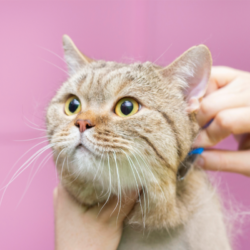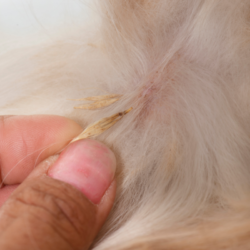Allergic-type diseases are a major concern in animal health, affecting a wide range of species including dogs, cats and horses. These pathological conditions, resulting from an overactive immune response to normally harmless substances, manifest themselves through a variety of symptoms that can significantly alter the quality of life of the animals concerned.
Emphysema in horses
Equine asthma, also known as emphysema, is a group of allergic respiratory diseases. These diseases have a major impact on the health and performance of horses. As the second main cause of poor performance, they highlight the need for early detection and effective management. This helps to improve the well-being of sport and race horses.
Emphysema in horses often results from exposure to allergens such as dust, mould and pollen. These allergens trigger chronic inflammation of the airways. There are two main forms of this disease. On the one hand, moderate equine asthma (MEA) affects horses of all ages. It is characterised by occasional coughing and reduced tolerance to exercise. Severe equine asthma (SEA) mainly affects older horses. This form is characterised by constant coughing, very sensitive bronchi and serious breathing difficulties at rest.
Emphysema is part of equine asthma. It shows a tendency towards allergies, with significant inflammation and blockage of the airways. Symptoms vary greatly, from simple discomfort to severe breathing problems. This shows that every animal reacts differently to environmental allergens.
Diagnosis of equine asthma, including emphysema, is based on several factors. It begins with a clinical examination. Airway endoscopy follows. Next, a bronchoalveolar lavage is performed. These steps enable inflammation to be assessed and mucus to be detected. Management of this condition includes changes to the environment. The aim is to reduce contact with allergens. Medical treatment is also necessary. Its aim is to control inflammation and alleviate symptoms.
Recurrent summer dermatitis in equines
Summer dermatitis, also known as recurrent equine summer dermatitis (RESD), is a seasonal allergy affecting the skin of horses, triggered by the bites of insects such as flies, horseflies and, above all, midges of the Culicoides genus. This condition, marked by intense itching and skin inflammation, can lead to sores on the animal’s skin. Treatment is based on the use of antiseptics and soothing lotions, but prevention remains the most effective strategy against this disease.
EERD is characterised by hypersensitivity to insect saliva, with symptoms exacerbated in the warmer months and subsiding in autumn. Affected areas mainly include the neck, the base of the tail and sometimes the ears. Papules and partial alopecia due to intensive scratching are common clinical signs. Progression to chronicity is possible, with lesions persisting into winter.
Prevalence varies from region to region, and may reach 1 in 10 horses in France, with particular susceptibility in certain breeds, such as Icelandic horses. Risk factors include a genetic predisposition and environmental conditions that favour the presence of Culicoides.
Diagnosis is based on clinical observation and may be supplemented by skin biopsy. Prevention involves reducing exposure to bites through measures such as the use of mosquito nets, keeping horses sheltered during periods of peak insect activity, and the regular application of insecticides.
Canine atopic dermatitis
Canine atopic derm atitis is similar to human eczema. It is a skin inflammation of genetic origin. It affects 10% of dogs, often before the age of 3. The disease develops in flare-ups. It causes dry skin, red lesions and itching. Sometimes, pustules or thickening of the skin can also be observed. The areas most affected are the stomach, folds, spaces between the fingers, face and ears.
The major cause of this condition is a defect in the skin barrier. This leads to excessive water loss and makes it easier for allergens and microbes to penetrate. This triggers an inflammatory reaction. Although there is no cure, appropriate treatment can control the symptoms.
Symptoms, which generally appear between 6 months and 3 years of age, vary depending on exposure to allergens, and can be intensified depending on the season. Clinically, the disease is characterised by red patches, pruritus, papules and hair loss, mainly on contact and rubbing areas.
Predisposed breeds include Labradors, Golden Retrievers, French Bulldogs and others. Diagnosis is based on symptoms, age, and exclusion of other causes of itching, which can be confirmed by allergy testing.
Management involves eliminating allergens, using soothing shampoos, moisturising sprays and, under veterinary prescription, a hypoallergenic diet or medication to reduce inflammation and itching. Regular anti-parasite treatments and rigorous hygiene are essential to prevent attacks.
Potential complications include superinfections by bacteria or fungi. Although atopic dermatitis is a lifelong condition, proactive management can help maintain a satisfactory quality of life for affected dogs.
Flea allergy dermatitis
Flea Allergy Dermatitis (FAD) is a common allergic reaction in cats and dogs, induced by flea saliva when bitten. This dermatological disease manifests itself as cutaneous hypersensitivity, leading to pruritus, red lesions and excoriations. In cats, the distinctive signs include scabs on the back and neck, and sometimes extensive alopecia or sores. In dogs, symptoms often occur in the dorsal-lumbar triangle, the back of the thighs and the flanks, with areas such as the head and toes rarely affected.
Diagnosis of DAPP is based on observation of the clinical symptoms, the areas affected and the presence of flea droppings, which show an orange colour on a moistened surface. Specific allergological tests are rarely performed, as their usefulness is limited by a lack of specificity.
Treatment for DAPP is aimed at reducing inflammation and itching, involving the use of cortisone, local care (shampoos, sprays) to calm symptoms, and a three-pronged strategy to control fleas: elimination of parasites on the animal, treatment of other household pets, and environmental sanitation. Regular use of effective anti-parasite products is essential to prevent re-infestation.
The prognosis is often good, with improvements following treatment. However, the disease may return if fleas are not controlled or if preventive treatment is stopped. Prevention is essential. It requires rigorous environmental hygiene and regular anti-parasite treatment. This applies to the animal concerned and to all the other animals in the household. This reduces the risk of new infestation. The result is a better quality of life for the animal.





